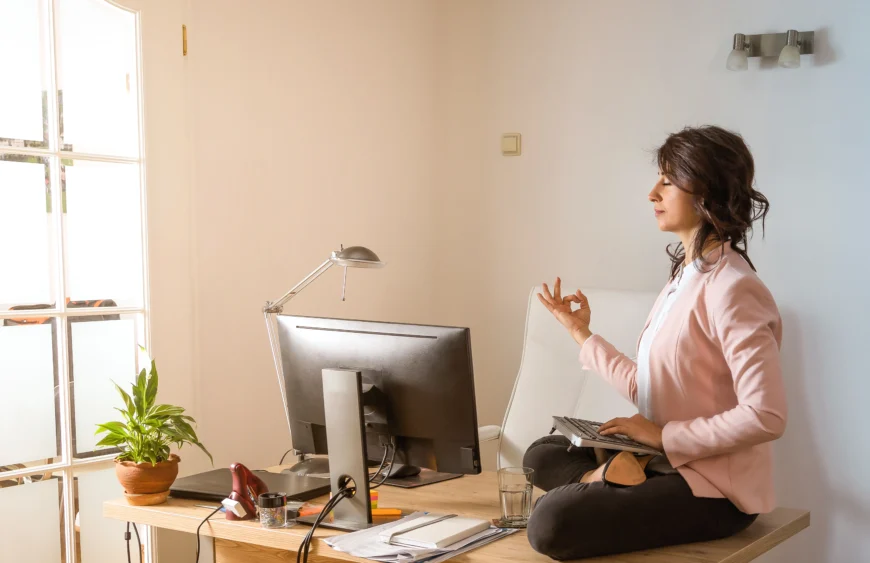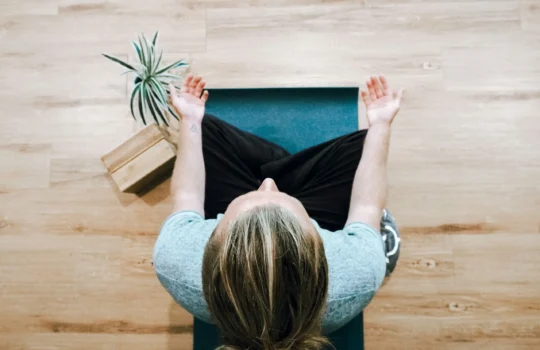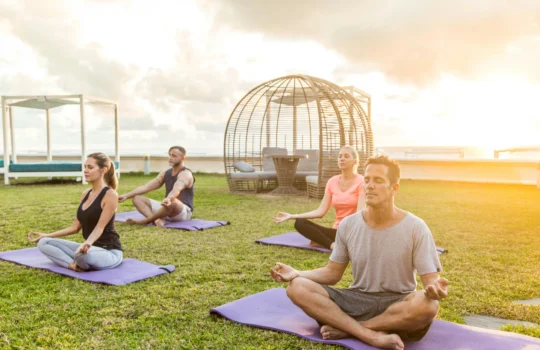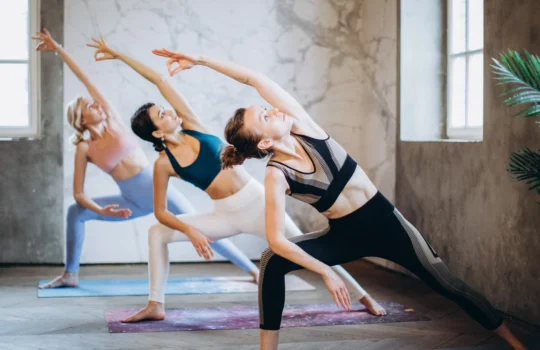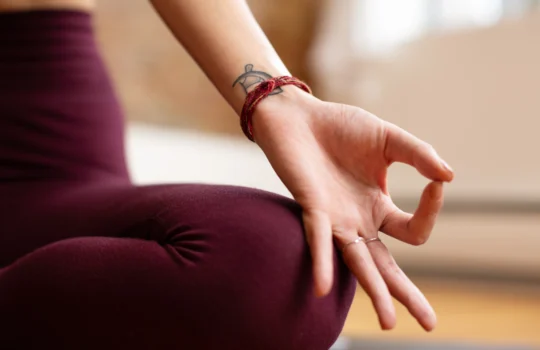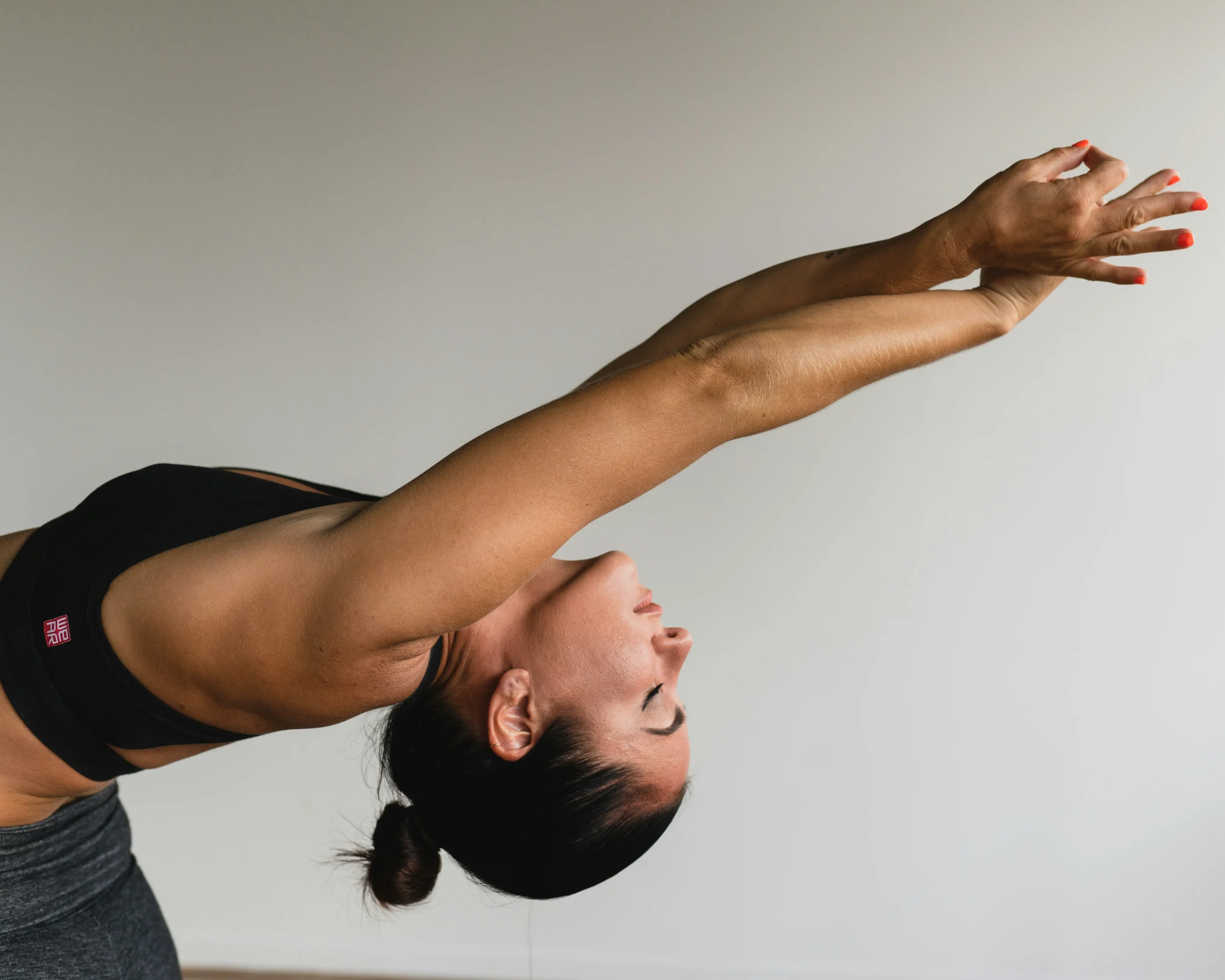As educators, you pour your heart and soul into nurturing young minds, but who takes care of the caretaker? In the demanding world of teaching, it’s crucial to maintain not only your intellectual health but also your physical and emotional well-being.
Yoga, a practice steeped in centuries of tradition, offers more than just a physical workout—it provides a toolkit for resilience, focus, and rejuvenation. Whether you’re dealing with classroom chaos or administrative challenges, integrating yoga into your daily routine can lead to profound improvements in your professional life.
In this post, we’ll uncover nine yoga secrets that can elevate your teaching experience, enhance your classroom presence, and potentially transform your educational environment. Get ready to stretch beyond your limits and discover how yoga can harmonize your professional endeavors!
Table of Contents
Understanding the Connection Between Yoga and Teaching
Yoga and teaching share a fundamental connection—both require patience, dedication, and a deep understanding of human nature. The practice of yoga not only improves flexibility and physical health but also enhances mental clarity, emotional stability, and overall resilience. These qualities are essential for teachers who face the daily challenges of managing diverse student needs and dynamic classroom environments.
Yoga Enhances Self-awareness and Empathy
Yoga encourages practitioners to delve into self-awareness. This heightened awareness of one’s own body, emotions, and thoughts can translate into better classroom management and student engagement. By understanding your own triggers and responses, you can more effectively manage stress and provide a calm, stable environment for your students.
Physical Health Benefits Support Daily Teaching Demands
Teaching can be physically demanding—long hours on your feet, bending over desks, and the occasional sprint down the hallway. Regular yoga practice strengthens the muscles, increases stamina, and can reduce the risk of injury. This physical resilience allows teachers to meet the demands of their day without undue fatigue or physical stress.
Mental Clarity for Better Decision Making
One of the most significant benefits of yoga is improved concentration and mental clarity. Through practices like meditation and focused breathing, yoga helps clear the mind of clutter. This clarity can lead to more effective lesson planning, sharper focus during classroom interactions, and better decision-making skills. When teachers feel mentally clear and focused, they can guide their students more effectively and handle complex classroom situations with ease.
Secret #1: Start Your Day with Sun Salutations
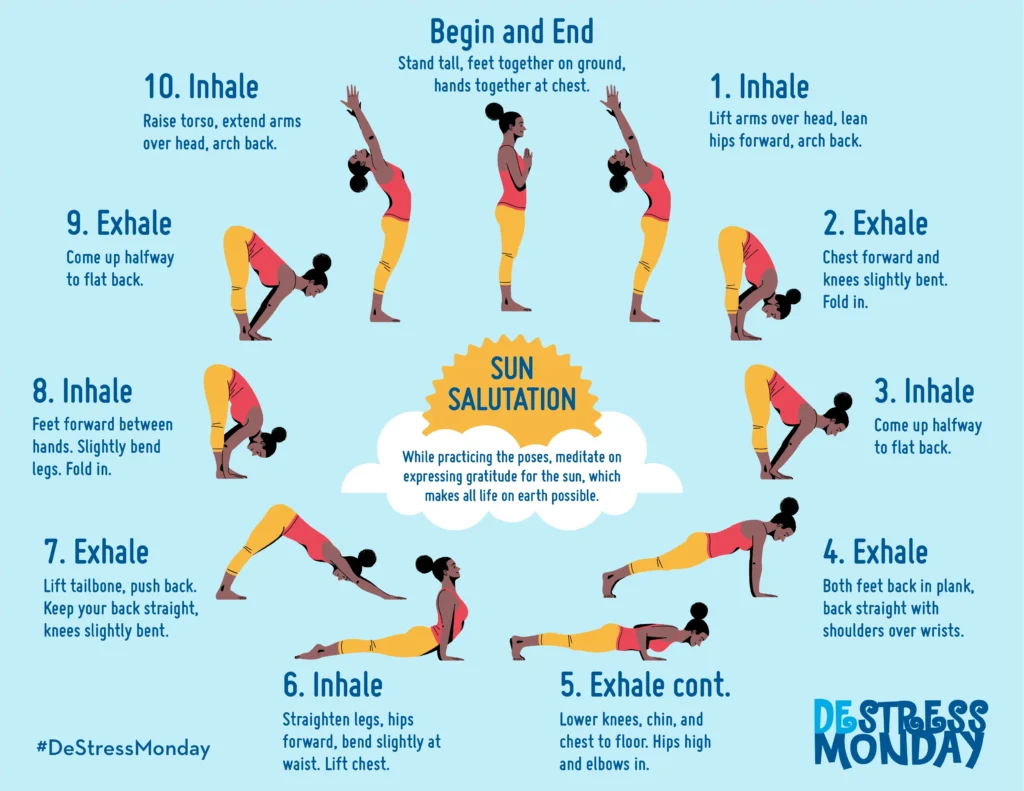
Beginning your day with a sequence of Sun Salutations, or Surya Namaskar, is a powerful way to awaken your body, focus your mind, and prepare yourself for the challenges ahead. This series of yoga poses not only warms up the muscles and joints but also integrates breathing and movement, setting a mindful tone for the day.
The Power of a Morning Routine
Incorporating Sun Salutations into your morning routine can energize you, reduce stress, and enhance mental clarity. As a teacher, starting your day feeling centered and energized can make a significant difference in how you interact with students and handle the day’s pressures.
Step-by-Step Guide to Sun Salutations
- Mountain Pose (Tadasana): Stand with your feet together, hands at your sides, evenly distributing your weight.
- Upward Salute (Urdhva Hastasana): Inhale and stretch your arms above your head.
- Standing Forward Bend (Uttanasana): Exhale as you fold forward from the hips, hands reaching down to the floor.
- Half Standing Forward Bend (Ardha Uttanasana): Inhale, lift your torso halfway up, hands on shins, back flat.
- Plank Pose: Step or jump back into a plank, maintaining a strong core.
- Chaturanga Dandasana: Lower your body to hover a few inches above the ground.
- Upward-Facing Dog (Urdhva Mukha Svanasana): Inhale and push your chest forward, lifting through the spine.
- Downward-Facing Dog (Adho Mukha Svanasana): Exhale and lift your hips, pressing back into a V shape.
- Return to Half Standing Forward Bend, then to Standing Forward Bend, and finally rise to Upward Salute and back to Mountain Pose.
Practicing this sequence daily not only boosts physical health but also instills a routine that promotes mental and emotional stability.
Secret #2: Incorporate Breathing Exercises for Stress Management
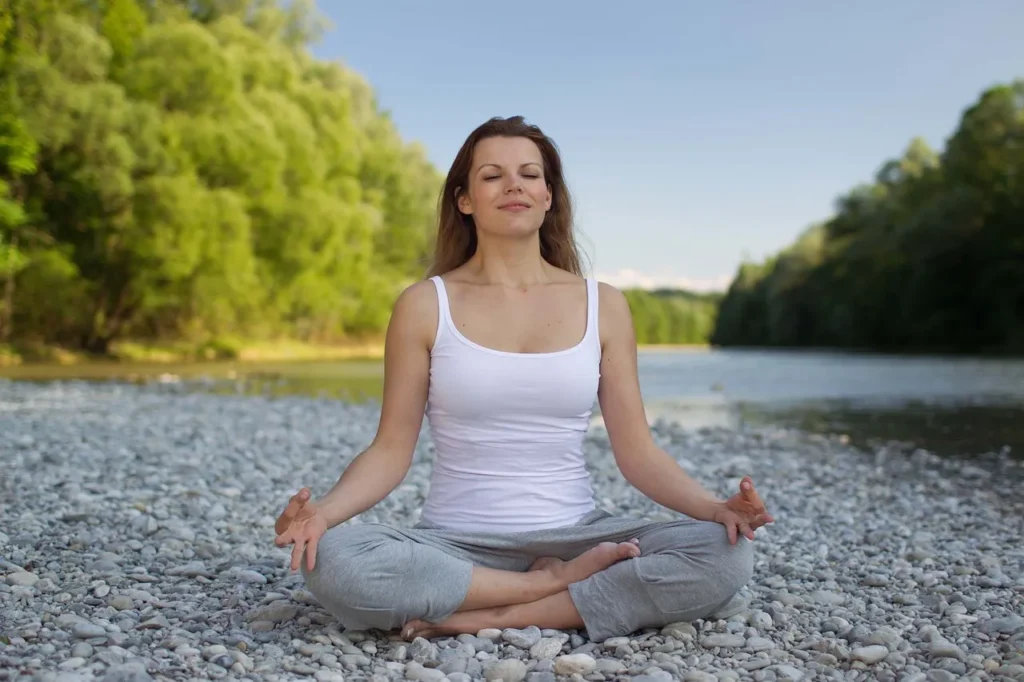
Breathing exercises, or Pranayama, are a cornerstone of yoga that can significantly aid in stress management—crucial for any teacher. By learning to control your breath, you can influence your emotional state, calming the mind and reducing anxiety.
Benefits of Controlled Breathing
Controlled breathing can lower blood pressure, reduce stress hormones, and help manage the emotional highs and lows of teaching. Integrating these practices can make you more resilient to classroom stressors, enhancing your ability to stay calm and collected.
Simple Breathing Techniques You Can Use Anywhere
- Equal Breathing (Sama Vritti): Inhale for a count of four, then exhale for a count of four. This simple technique is excellent for calming the nervous system and can be done even while teaching.
- Abdominal Breathing: Place one hand on your stomach and the other on your chest. Inhale deeply through your nose, ensuring your diaphragm inflates with enough air to create a stretch in your lungs. Slowly exhale. This is particularly effective before class or during breaks.
- Alternate Nostril Breathing (Nadi Shodhana): This technique involves holding one nostril closed while breathing through the other and then switching. It’s great for reducing stress and improving focus before grading or planning.
By starting your day with Sun Salutations and using breathing exercises throughout, you can significantly enhance your mental, physical, and emotional health, which are all vital for being an effective teacher.
Secret #3: Use Chair Yoga to Stay Energized
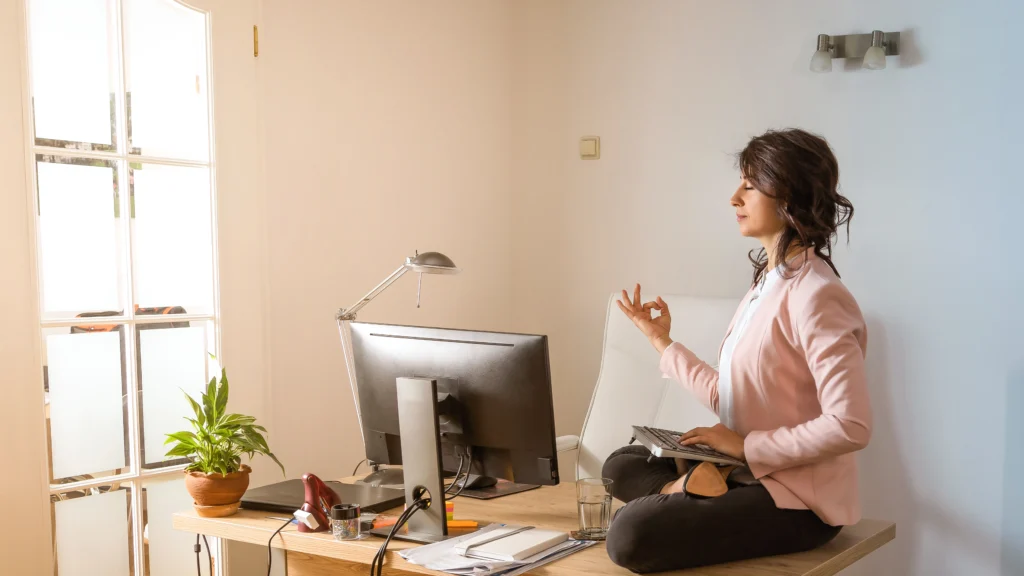
For teachers, being active and energized throughout the day can be challenging, especially during periods of extensive paperwork or long hours of seated activities. Chair yoga is a fantastic way to integrate movement and flexibility exercises without leaving your desk.
Benefits of Chair Yoga for Teachers
Chair yoga can prevent the stiffness and discomfort associated with prolonged sitting. It’s also easily performed in a classroom setting or during short breaks, offering immediate relief and revitalization which are essential for maintaining energy and enthusiasm in teaching.
Simple Chair Yoga Poses You Can Do Anytime
- Seated Cat-Cow Stretch: Sit at the edge of your chair with feet flat on the floor. Place your hands on your knees. As you inhale, arch your back and look up, pulling your shoulders back (Cow). As you exhale, round your back and drop your chin to your chest (Cat). This helps in loosening the back muscles.
- Seated Crescent Moon Pose: Lift your arms overhead, linking your fingers and stretching to the right for a deep side stretch. Hold for a few breaths, then switch to the left side. This pose helps in stretching the spine and sides, reducing neck and shoulder tension.
- Chair Pigeon Pose: While seated, place one ankle on the opposite knee, keeping the knee in line with your ankle as much as possible. Lean forward to intensify the stretch in your hip and buttock. Switch legs after a few breaths. This pose is great for releasing tension in the hip area, which can get tight from sitting.
Secret #4: Enhance Focus with Concentration Poses

Yoga isn’t just about physical flexibility; it’s also about mental acuity. Concentration poses help enhance cognitive function, crucial for teachers who need to maintain high levels of attention throughout the day.
The Role of Concentration Poses in Mental Clarity
These poses aid in developing focus, patience, and endurance, directly impacting your teaching abilities by enhancing your capacity to concentrate on multiple tasks and student needs.
Key Yoga Poses to Improve Focus
- Tree Pose (Vrikshasana): Stand on one leg, place the other foot on your inner thigh, and balance. Focus your gaze on a fixed point in front of you. This pose improves balance and stability in the mind and body.
- Eagle Pose (Garudasana): From a standing position, cross one thigh over the other and hook the top of the foot behind the lower calf. Cross the arms at the elbows and wrists in front of you. Balancing in this pose helps focus the mind and also aids in joint flexibility.
- Warrior III (Virabhadrasana III): Step one foot back and lean forward, forming a straight line from your head to your back foot, hands extended in front or to the sides. This pose enhances core strength and improves concentration and balance.
By integrating these practices into your daily routine, not only can you stay energized but also significantly boost your focus and mental clarity—key components for effective teaching.
Secret #5: Practice Yoga for Emotional Resilience
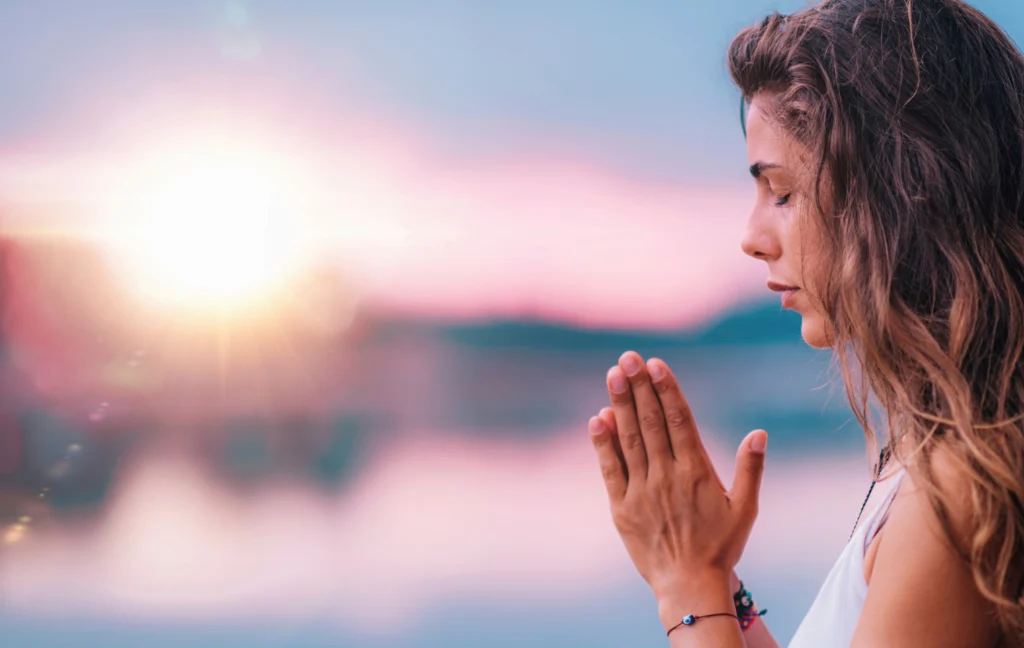
Teaching can be emotionally draining. From managing classroom dynamics to coping with the varying needs of students, teachers often face emotional highs and lows. Yoga offers tools to build emotional strength and resilience, helping teachers navigate these challenges with greater ease.
Benefits of Yoga for Emotional Stability
Yoga promotes emotional health by reducing anxiety, depression, and stress. It helps cultivate a state of mind that can better manage emotional stressors, enabling teachers to maintain a supportive and positive classroom environment.
Yoga Practices for Building Emotional Resilience
- Child’s Pose (Balasana): A soothing pose that helps calm the brain and relieve stress and fatigue. This pose is also great for contemplation and reflection, encouraging emotional release and comfort.
- Warrior II (Virabhadrasana II): This pose boosts confidence and helps improve stamina. Holding the pose and maintaining focus can teach endurance and patience, essential qualities in emotional management.
- Forward Bend (Uttanasana): Helps calm the mind and soothe the nerves. By reversing the blood flow, this pose refreshes and revitalizes the brain, making it easier to handle emotional stress.
Read more about Emotion Regulation: Why Pranayamas Are Better Than You’d Think?
Secret #6: Use Yoga to Improve Communication Skills

Effective communication is a cornerstone of teaching. Yoga can enhance both verbal and non-verbal communication skills, making interactions with students and colleagues more effective and empathetic.
How Yoga Enhances Communication
The practice of yoga improves mindfulness, which in turn enhances the way we listen and respond to others. Being present in the moment can lead to more thoughtful and clear communication, crucial for teaching.
Yoga Techniques to Foster Better Communication
- Throat Chakra Poses (Vishuddha): Focus on poses that open and activate the throat chakra, the center of communication. Examples include:
- Fish Pose (Matsyasana): Opens up the throat, chest, and shoulders, encouraging better alignment and clearer respiratory passages.
- Lion’s Pose (Simhasana): An energizing pose that stimulates the platysma (a thin, rectangular-shaped muscle in the front of the throat). This pose is excellent for releasing tension in the face and jaw, areas where we often hold stress that can impact communication.
- Group Yoga Classes: Participating in group yoga classes can also help improve communication skills. The need to follow verbal instructions and the opportunity to engage with peers can enhance listening skills and collaborative communication.
By incorporating these yoga practices into your routine, not only can you manage the emotional demands of teaching more effectively, but you can also enhance your ability to communicate clearly and effectively—whether in the classroom or in personal interactions.
Secret #7: Develop Patience Through Meditation
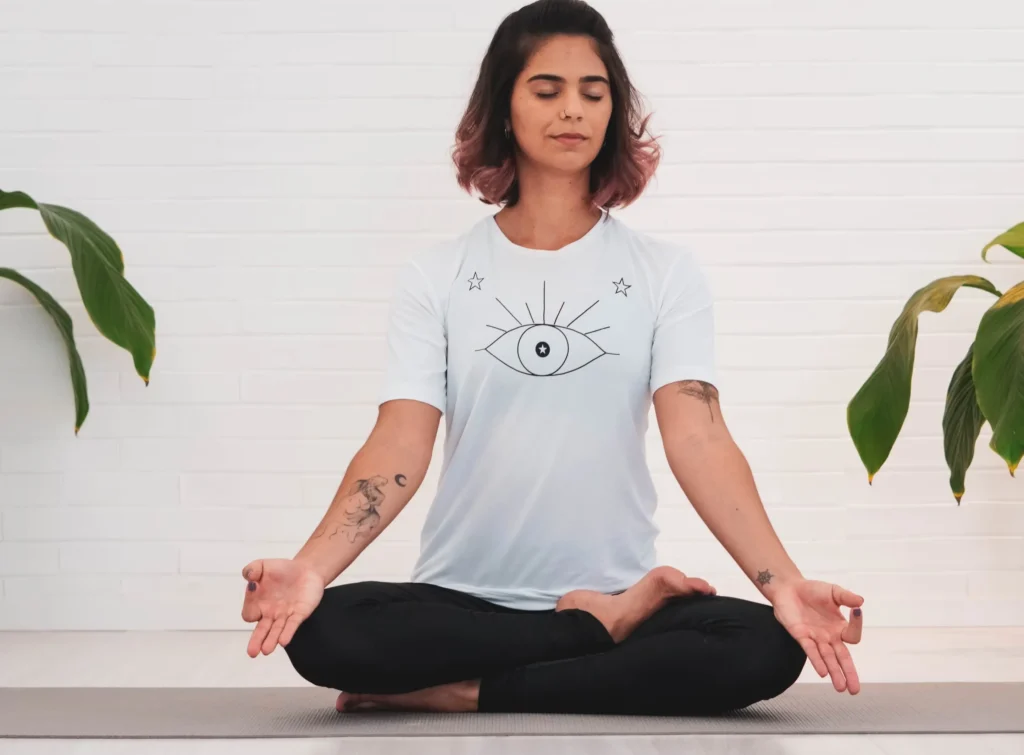
Patience is a vital trait for teachers, necessary for dealing with various classroom situations and student behaviors. Meditation, a core aspect of yoga, can significantly enhance one’s capacity for patience by calming the mind and reducing impulsivity.
The Impact of Meditation on Patience
Meditation helps in slowing down the thought process, allowing for more measured responses and increased tolerance. Regular meditation can lower stress levels, improve emotional regulation, and enhance overall mental health, contributing to greater patience in professional and personal interactions.
Meditation Techniques for Teachers
- Mindfulness Meditation: Focus on your breath or a specific object. This practice helps keep you present and aware, reducing reactionary behavior and fostering patience.
- Guided Meditation: Use audio recordings or apps designed for meditation. These can guide you through relaxation and visualization techniques, ideal for busy teachers who need structured downtime.
- Loving-kindness Meditation (Metta Bhavana): Focus on developing feelings of goodwill, kindness, and warmth towards others, which can greatly increase empathy and patience.
Read more about How Yoga Meditation Changed My Life: 5 Inspiring Personal Stories
Read more about 10 Solid Benefits of Investing in a Quality Meditation Mat
Secret #8: Yoga for Physical Endurance
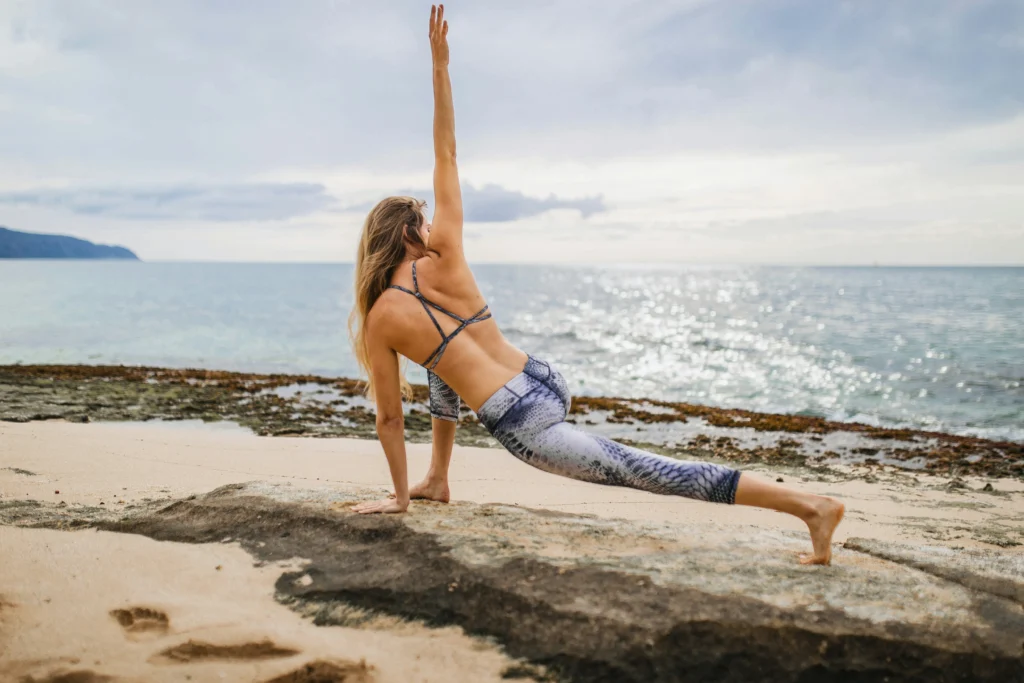
Teaching is not just a mentally but also physically demanding profession. Yoga can build the physical endurance needed to handle long hours of standing, bending, and engaging actively with students.
Benefits of Yoga for Physical Strength
Regular yoga practice increases core strength, stamina, and flexibility. These physical benefits are crucial for teachers, who need to be on their feet for extended periods and handle physically demanding tasks.
Yoga Poses for Enhancing Physical Endurance
- Plank Pose (Phalakasana): Builds core strength and endurance. Holding a plank is an excellent way for teachers to build physical stamina that supports prolonged standing and activity.
- Chair Pose (Utkatasana): This pose mimics the act of sitting in a chair but without any support, which strengthens the thighs and legs and builds endurance in the lower body.
- Warrior I (Virabhadrasana I): Enhances the stamina of the legs and core muscles while also opening the chest and shoulders, improving posture and respiratory capacity.
By engaging in these practices, teachers can develop the patience to handle challenging interactions more gracefully and the endurance to physically withstand the demands of their profession.
Secret #9: Create a Balanced Life with Yoga Philosophy

Yoga is more than just physical poses; its philosophy offers a rich framework for leading a balanced life, which is especially beneficial for teachers who juggle multiple responsibilities. By adopting yoga philosophy, teachers can gain insights into managing their energy, prioritizing tasks, and maintaining harmony in their personal and professional lives.
Key Principles of Yoga Philosophy for Teachers
- Ahimsa (Non-violence): This principle encourages compassion and non-harm towards oneself and others. For teachers, this means practicing self-care and understanding, which can prevent burnout and foster a nurturing classroom environment.
- Satya (Truthfulness): Emphasizing honesty in communication with students and colleagues can build trust and create a positive learning environment.
- Santosha (Contentment): This principle teaches satisfaction with what one has, an important aspect for teachers who often face challenging conditions and limited resources.
Applying Yoga Philosophy in Daily Teaching
- Incorporate mindfulness and meditation into your daily routine to stay aligned with these principles.
- Reflect on these philosophical teachings regularly to make more informed, ethical, and compassionate choices in the classroom.
Read more about How Yoga Helps You Meet the Best Version of Yourself
Bonus Secret: Create an Instagram Account to Share Your Valuable Insights with Your Audience

In today’s digital age, social media is a powerful tool for sharing knowledge and building communities. For teachers practicing yoga, creating an Instagram account dedicated to your journey can not only inspire others but also keep you motivated and accountable.
Why Instagram is Beneficial for Teachers
- Visual Engagement: Instagram is highly visual, making it ideal for sharing photos and videos of yoga poses, meditation techniques, and classroom activities.
- Build a Community: It allows you to connect with other educators and yoga enthusiasts worldwide, fostering a sense of community and shared learning.
- Instant Feedback: Share your progress and receive immediate support and feedback from peers, which can enhance your teaching and personal growth.
Tips for Using Instagram Effectively
- Consistency is Key: Post regularly to keep your audience engaged. Aim for a mix of content types, including quick tips, success stories, personal reflections, and live sessions.
- Educational Content: Use your platform to educate your followers about the benefits of yoga, how it can be integrated into the classroom, and personal testimonials about its impact.
- Interactive Posts: Encourage interaction by asking questions, running polls, or challenges. This can increase engagement and make your followers feel like part of a community.
- Hashtags and Collaborations: Utilize relevant hashtags to reach a wider audience and consider collaborating with fellow yoga practitioners or educational professionals to expand your network.
Wrapping It Up
By integrating yoga into your life and sharing your journey on platforms like Instagram, you not only enhance your own practice but also inspire and support others in the teaching community. Digital tools like Instagram can amplify your impact, spreading the benefits of yoga across the educational landscape and creating connections that enrich your professional and personal life.
Ready to Take the First Step?
Now that you’re equipped with these yoga secrets and the know-how to share them, why not take the first step today? Create your Instagram profile, share your first post, and become part of a growing network of educators who are transforming their teaching through yoga. Don’t forget to use the hashtag #YogaForTeachers to connect with and inspire a global audience. We can’t wait to see how you bring these practices to life both in and out of the classroom!
Conclusion
Yoga offers a wealth of benefits that extend far beyond the physical. For teachers, incorporating these nine yoga secrets into your daily routine can transform not just your teaching style but also your personal well-being and professional effectiveness. From enhancing physical endurance to fostering emotional resilience and improving communication skills, yoga provides tools that can support every aspect of your teaching life.
Share Your Experience
Are you ready to transform your teaching and personal life with yoga? Start small by incorporating one or two of these practices into your daily routine, and observe the changes in your stress levels, energy, and interaction with students. Share your experiences with us in the comments below or reach out if you have questions or need guidance on your yoga journey. Remember, even the smallest step towards a healthier lifestyle can make a significant difference in your professional and personal fulfillment.

